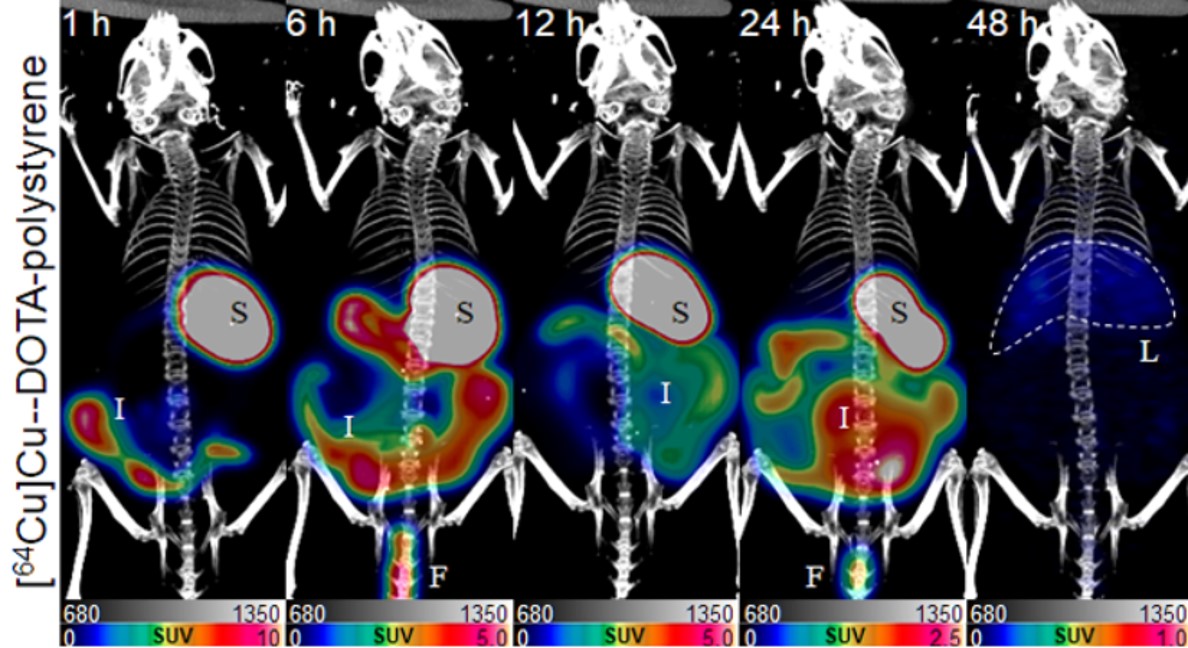글로벌 연구동향
분자영상 및 방사화학
- [J Nucl Med.] PET tracing of biodistribution for orally administered 64 Cu-labeled polystyrene in mice 미세플라스틱의 체내 이동 경로 확인 (64Cu로 표지된 폴리스티렌 PET 영상을 이용한 미세플라스틱의 생체 분포 확인)
KIRAMS / 임창근, 김현기, 강충모*, 김진수*
- 출처
- J Nucl Med.
- 등재일
- 2021 Jul 2
- 저널이슈번호
- jnumed.120.256982. doi: 10.2967/jnumed.120.256982. Online ahead of print.
- 내용
-
Abstract
Purpose: Plastics are used commonly in the world because of its convenience and cost-effectiveness. Microplastics, an environmental threat and human health risk, are widely detected in food, and consequently ingested. However degraded plastics are found everywhere, which cause environmental threat and human health risk. Therefore, real-time monitoring of orally administered microplastics is tremendously important to trace them in the body. Methods: In this study, to visualize their absorption path, we labeled polystyrene with [64Cu]Cu-DOTA. We prepared radiolabeled polystyrene with 64Cu after, [64Cu]Cu-DOTA-polystyrene was then orally administered to mice and evaluate its transit and absorption in mice using PET imaging. The absorption path and distribution of [64Cu]Cu-DOTA-polystyrene were determined using positron emission tomography (PET) over 48 h. Ex vivo tissue-radio thin-layer chromatography (Ex vivo-radioTLC) was used to demonstrate the existence of [64Cu]Cu-DOTA-polystyrene in tissue. Results: PET images demonstrated that [64Cu]Cu-DOTA-polystyrene began to transit to the intestine within 1 h. [64Cu]Cu-DOTA-polystyrene accumulation in the liver was also observed. Biodistribution of [64Cu]Cu-DOTA-polystyrene confirmed the observed distribution of [64Cu]Cu-DOTA-polystyrene from PET images. Ex vivo-radioTLC was used to demonstrate that the detected gamma rays originated from [64Cu]Cu-DOTA-polystyrene. Conclusion: This study provided evidence of microplastic accumulation and existence in tissue by using PET imaging, and cross confirmed by ex vivo-radioTLC. The information provided may be used as the basis for future studies on the toxicity of microplastics.
64Cu-DOTA-폴리스티렌 체내 흡수 경로 PET 영상
Affiliations
Changkeun Im 1 , Hyeongi Kim 1 , Javeria Zaheer 1 , Jung Young Kim 1 , Yong Jin Lee 2 , Choong Mo Kang 2 , Jin Su Kim 2
1 Korea Institute of Radiological & Medical Sciences.
2 Korea Institute of Radiological and Medical Sciences, Korea, Republic of.
- 키워드
- 64Cu-DOTA-PS; Animal Imaging; Cu-64; Microplastic; PET; Polystyrene; Positron emission tomography; Radiochemistry.
- 연구소개
- 전세계적으로 미세플라스틱으로 인한 생태계 오염이 심각하며, 해산물을 포함한 다수의 먹거리에서 미세플라스틱이 검출됨을 확인하였다. 따라서 이제는 미세플라스틱으로부터 자유로울 수 없는 환경이며, 음식물에 포함된 미세플라스틱을 섭취했을 때 생체 내 흡수되는 경로를 파악하였다. 흔히 사용되는 미세플라스틱 중 폴리스티렌에 킬레이터인 DOTA을 결합하고 64Cu를 표지하여 64Cu-DOTA-폴리스티렌을 합성하였으며, 마우스에 경구투여 후 1, 6, 12, 24, 48시간에 PET영상과 적출된 장기를 감마카운터로 계수하여 체내분포를 확인하였으며, thin-layer chromatography를 통해 조직에서 검출되는 64Cu가 어떤 화학적 형태인지 분석하였다. 미세플라스틱은 경구섭취 후 1시간에 위와 장으로 이동하였으며, 24시간이 지나도록 위에서 계속 머물렀다. 48시간에 위와 장에서 대부분 빠져나간 반면 간에는 초기 1시간 째(섭취량의 0.5%)에 비해 5배 늘어났다. 그 뿐만 아니라 1시간 이내에 심장, 혈액, 폐를 포함한 전신에서 섭취량의 0.1% 수준의 미세플라스틱이 퍼져 나간 것을 확인하였다.
- 덧글달기
- 이전글 [J Immunother Cancer.] Escherichia coli adhesin protein-conjugated thermal responsive hybrid nanoparticles for photothermal and immunotherapy against cancer and its metastasis
- 다음글 [Biochem Biophys Res Commun.] In vivo evaluation of PEGylated-liposome encapsulating gadolinium complexes for gadolinium neutron capture therapy










편집위원
미세플라스틱의 체내 축적 경로를 PET 영상을 이용하여 밝힌 논문으로,최근 심각한 환경문제의 하나로 나타나고 있는 미세플라스틱의 위험성과 이에 대한 해결책을 연구하는데 많은 기여를 할 수 있는 흥미로운 연구라고 생각됨. 미세플라스틱의 독성 평가에 대한 후속 연구가 기대됨.
2021-07-27 14:51:55
편집위원2
플라스틱은 활용도가 매우 높음에도 불구하고, 위해성으로 인해 생체내 유입된 미세플라스틱의 실시간 모니터링 연구가 필요한 상황이다. 본 연구는 polystyrene을 [64Cu]Cu-DOTA로 표지하여 PET을 통해 미세플라스틱의 세포내 유입 경로와 조직내 축적을 확인함으로써, 향후 미세플라스틱의 독성연구에 많은 정보를 제공할 수 있을 것으로 기대된다.
2021-07-27 14:52:18
편집위원3
이 논문은 대략 0.2 um (223–224 nm) 크기의 미세플라스틱인 polystyrene에 Cu-64를 표지한 [Cu-64]Cu-DOTA-polystyrene을 마우스의 입을 통해 주입한 후 PET 영상으로 시간별 미세플라스틱의 체내 이동경로 및 각 장기 섭취율을 확인한 것으로, 현대인이 일상에서 늘 사용하는 미세플라스틱이 인체에 미치는 영향을 동물 PET 영상을 이용하여 확인한 연구다.
2021-07-27 14:56:32